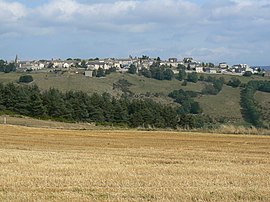Châteauneuf-de-Randon
Chastèlnòu de Randon (Occitan) | |
|---|---|
 A general view of Châteauneuf-de-Randon | |
| Coordinates: 44°38′29″N 3°40′34″E / 44.6414°N 3.6761°E | |
| Country | France |
| Region | Occitania |
| Department | Lozère |
| Arrondissement | Mende |
| Canton | Grandrieu |
| Government | |
| • Mayor (2020–2026) | Bruno Durand[1] |
| Area 1 | 24.49 km2 (9.46 sq mi) |
| Population (2021)[2] | 523 |
| • Density | 21/km2 (55/sq mi) |
| Time zone | UTC+01:00 (CET) |
| • Summer (DST) | UTC+02:00 (CEST) |
| INSEE/Postal code | 48043 /48170 |
| Elevation | 1,116–1,339 m (3,661–4,393 ft) (avg. 1,286 m or 4,219 ft) |
| 1 French Land Register data, which excludes lakes, ponds, glaciers > 1 km2 (0.386 sq mi or 247 acres) and river estuaries. | |
Châteauneuf-de-Randon (French: [ʃɑtonœf də ʁɑ̃dɔ̃]; Occitan: Chastèlnòu de Randon) is a village and commune in the Lozère department in southern France.
History
[edit]The battle of Châteauneuf-de-Randon was fought in 1380 between the English and the French. In 1380 the fortress of Châteauneuf-de-Randon was besieged by the French, under the command of Bertrand du Guesclin, and the fortress was defended by an English garrison under De Ros. The town surrendered on the 4th of July. The siege, however, was fatal to the French commander.
Geography
[edit]The Chapeauroux forms part of the commune's western border, flows eastward through the middle of the commune, then forms part of its eastern border.
See also
[edit]References
[edit]- ^ "Répertoire national des élus: les maires" (in French). data.gouv.fr, Plateforme ouverte des données publiques françaises. 13 September 2022.
- ^ "Populations légales 2021" (in French). The National Institute of Statistics and Economic Studies. 28 December 2023.
External links
[edit]




Well, that’s interesting to know that Psilotum nudum are known as whisk ferns. Psilotum nudum is the commoner species of the two. While the P. flaccidum is a rare species and is found in the tropical islands. Both the species are usually epiphytic in habit and grow upon tree ferns. These species may also be terrestrial and grow in humus or in the crevices of the rocks.
View the detailed Guide of Psilotum nudum: Detailed Study Of Psilotum Nudum (Whisk Fern), Classification, Anatomy, Reproduction